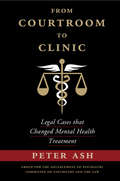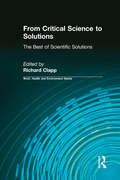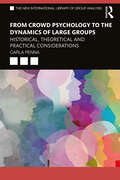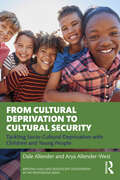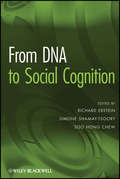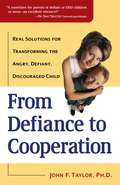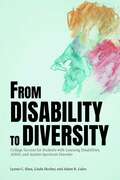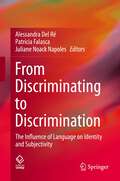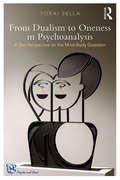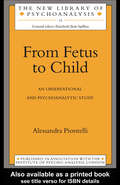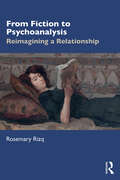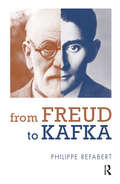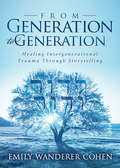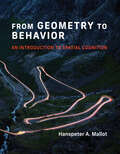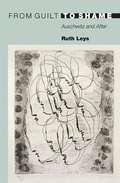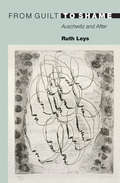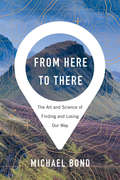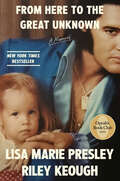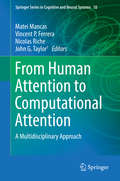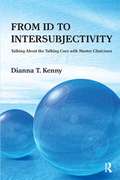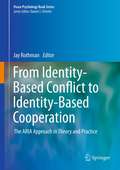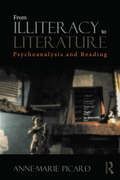- Table View
- List View
From Courtroom to Clinic: Legal Cases that Changed Mental Health Treatment
by Peter AshWhy do present-day mental health professionals practice the way that they do? Over the past fifty years, a number of landmark court holdings have changed such basic principles as what material is confidential, how civil commitment and involuntary treatment are conducted, and when a therapist has a duty to protect the public from a dangerous patient. Unlike most legal texts, this volume explores these complex principles through the human stories of the litigants involved.
From Critical Science to Solutions: The Best of Scientific Solutions (Work, Health and Environment Series)
by Richard ClappFirst Published in 2017. Routledge is an imprint of Taylor & Francis, an Informa company.
From Crowd Psychology to the Dynamics of Large Groups: Historical, Theoretical and Practical Considerations (The New International Library of Group Analysis)
by Carla PennaFrom Crowd Psychology to the Dynamics of Large Groups offers transdisciplinary research on the history of the study of social formations, ranging from nineteenth-century crowd psychology in France and twentieth-century Freudian mass psychology, including the developments in critical theory, to the study of the psychodynamics of contemporary large groups. Carla Penna presents a unique combination of sociology, psychoanalysis, and group analysis in the study of social formations. This book revisits the epistemological basis of group analysis by introducing and discussing its historical path, especially in connection with the study of large groups and investigations of the social unconscious in persons, groups, and societies. It also explores early work on group relations and contemporary research on the basic-assumption group in England, particularly Hopper’s theory of Incohesion as a fourth basic assumption. From Crowd Psychology to the Dynamics of Large Groups enables the reader to map out the field of the unconscious life of crowds illuminating the darkness of twenty-first century collective movements. The reflections in this book present new perspectives for psychologists, psychoanalysts, group analysts, sociologists, and historians to investigate the psychodynamics of contemporary crowds, masses, and social systems.
From Cultural Deprivation to Cultural Security: Tackling Socio-Cultural Deprivation with Children and Young People (Applying Child and Adolescent Development in the Professions Series)
by Dale Allender Arya Allender-WestThis important book considers how youth of color and other marginalized youth experience socio-cultural deprivation from the repetition of traumatic socio-historic experiences as well as from the institutions they interact with such as schools, mental health organizations, and social services agencies. Focusing on the importance of connection to cultural heritage, the book shows how young people’s cognitive development can be mediated in educational settings through humanizing and culturally sustaining rituals that build rapport and facilitate learning and healing.The authors define socio-cultural deprivation and locate its origins for marginalized youth in post-traumatic slave syndrome, post-apocalyptic stress syndrome and similar socio-historic trauma, epigenetic trauma, and contemporary trauma. They weave theory and research, autobiography, and professional anecdotes to identify and elaborate upon socio-cultural deprivation and to provide rituals for rapport-building that can be applied to classrooms, group counselling, social work practices, and other human-centred work. Rituals include those acknowledging indigeneity; exploring personal ancestry and alternative forms for those who have no connection to their biological family; healing experiences through yoga, meditation, progressive relaxation, and visualization practices; and explicit relationship-building activities.From Cultural Deprivation to Cultural Security will be a crucial text for training and practising psychologists, educators, social workers, youth workers and counsellors, concerned with the positive development of children, adolescents, and young adults.
From DNA to Social Cognition
by Richard Ebstein Soo Hong Chew Simone Shamay-TsooryDecision-making is an integral part of our daily lives. Researchers seek a complete understanding of the decision-making process, including the biological and social basis and the impact of our decisions. From DNA to Social Cognition fills a gap in the literature that brings together the methods, perspectives, and knowledge of the geneticists, neuroscientists, economists, and psychologists that are integral to this field of research. The editors' unique expertise ensures an integrated and complete compilation of materials that will prove useful to researchers and scientists interested in social cognition and decision-making.
From Death Instinct to Attachment Theory
by Tomas Geyskens Philippe Van HauteTwo leading psychoanalysts resolve the conflict between attachment theory and trauma theory.In From Death Instinct to Attachment Theory, Tomas Geyskens and Philippe Van Haute address a theoretical conflict at the heart of contemporary psychoanalysis. Analytic theory, especially the work of Melanie Klein, asserts the developmental primacy of infantile Hilflosigkeit and the trauma it inevitably inflicts; however, John Bowlby and other attachment theorists have shown that attachment to the mother is primary and instinctive—and not the result of traumatic helplessness.Geyskens and Van Haute resolve the apparent tension between the empirical fact of the primacy of attachment and the fundamental psychoanalytic theory of infantile trauma by drawing on Imre Hermann&’s distinction between natural development and subjective history. Arguing that Hermann&’s theory constitutes a workable clinical anthropology of attachment, they undertake a deep and revealing analysis of the work of Freud and Klein on the death instinct, trauma, and infantile sexuality; the critique leveled by attachment theorists like Bowlby; and the overlooked insights of the Hungarian School of Psychoanalysis.From Death Instinct to Attachment Theory offers an elegant answer to an important problem in psychoanalysis and provides new insight into the sort of clinical phenomena that led Freud to move beyond the pleasure principle in the first place.
From Defiance to Cooperation: Real Solutions for Transforming the Angry, Defiant, Discouraged Child
by John F. TaylorChange Your Child's Life! Turn Negative Behavior into Positive TraitsHow do you deal with a difficult and defiant child or teenager? What can you do if your child has been diagnosed with oppositional defiant disorder (ODD) or is resentful and constantly in trouble at school? Are there constructive ways to channel such oppositional energy and determination? Dr. John F. Taylor will tell you how. Inside, you'll find new hope and hundreds of specific, sensible, and easy-to-implement suggestions for improving life with a rebellious and argumentative child. Parents and teachers -- anyone who deals with difficult children, teens, or young adults -- will also learn how to tap the potential of these natural-born leaders by discovering how to: ·Understand why an oppositional attitude exists ·Open up new, safer avenues for children to express needs and wants ·Enhance communication, avoid common mistakes, and reduce undesirable behavior ·Teach a child conscience-based self-control ·And much more!From the Trade Paperback edition.
From Disability To Diversity: College Success For Students With Learning Disabilities, Adhd, And Autism Spectrum Disorder
by Lynne C. Shea Linda Hecker Adam R. LalorColleges and universities are seeing increasing numbers of students with a range of disabilities enrolling in postsecondary education. Many of these disabilities are invisible and, despite their potential for negative impact on students’ academic and social adjustment, some students will choose not to identify as having a disability or request support. Approaching disability from the perspective of difference, the authors of this new volume offer guidance on creating more inclusive learning environments on campus so that all students―whether or not they have a recognized disability―have the opportunity to succeed. Strategies for supporting students with specific learning disabilities, attention-deficit/hyperactivity disorder, autism spectrum disorder or who display learning and behavioral characteristics associated with these profiles are described. A valuable resource for instructors, advisors, academic support personnel, and others who work directly with college students.
From Discriminating to Discrimination: The Influence of Language on Identity and Subjectivity
by Juliane Noack Napoles Alessandra Del Ré Patrícia FalascaThis book adopts a multidisciplinary approach to try to answer the question of how do we, as human beings, go from the socially neutral linguistic act of discriminating external stimuli to the socially loaded act of promoting social discrimination though language? This contributed volume brings together works presented at the international event “From Discriminating to Discrimination – The Influence of Language on Identity and Subjectivity”. This was an online event hosted and organized by the Brandenburg University of Technology (BTU), Germany, in partnership with São Paulo State University (UNESP), Brazil, that brought together lecturers from different universities around the world. During the event, linguists, psychologists, language teachers, social workers and pedagogues got together to discuss how discriminating can be recognized as a natural and important ability of the human being in the early stages of life and, after that, how to avoid discriminatory acts against others. The debates held online took into account the important and necessary dialogue between linguistics and other social sciences to discuss the role played by language as a form of building subjectivity and teaching practices that can contribute to minimize discrimination and promote integration and acceptance in a broad sense, understanding the preponderant role of language in recognizing what is different (discriminating), without diminishing or excluding it (discrimination). From Discriminating to Discrimination: The Influence of Language on Identity and Subjectivity will help linguists, psychologists, educators, social workers and a broad range of social scientists working with cognitive, linguistic and educational studies understand the path taken by differentiation, from the beginning of the child's language development – when discrimination (of sounds, gestures, etc.) is essential for the acquisition of language to occur –, until the moment when differentiation, discrimination, ceases to be an essential factor and becomes a means of social segregation.
From Dualism to Oneness in Psychoanalysis: A Zen Perspective on the Mind-Body Question (Psyche and Soul)
by Yorai SellaFrom Dualism to Oneness in Psychoanalysis: A Zen Perspective on the Mind-Body Question focuses on the shift in psychoanalytic thought, from a view of mind-body dualism to a contemporary non-dualistic perspective. Exploring this paradigm shift, Yorai Sella examines the impact of the work of psychoanalysts and researchers, such as Winnicott, Bion, Daniel Stern and Kohut, and delineates the contributions of three major schools of psychoanalytic thought in which the non-dualistic view is exemplified: (1) intersubjective; (2) neuro-psychoanalytic; and (3) mystically inclined psychoanalysis. Reaching beyond the constraints of dualism, Sella delineates the interdisciplinary approaches leading to psychoanalysis's paradigm shift. Focusing on the unique contribution of Zen-Buddhism, the book draws on Ehei Dōgen's philosophy to substantiate the non-duality of subject and object, body and mind - ultimately leading from alienation and duality to what Bion has termed "at one-ment". The way in which psychoanalytic theory and practice may develop further along these lines is demonstrated throughout the book in a variety of clinical vignettes. This book will inform the practice of all psychoanalysts, mental health professionals, psychotherapists and clinicians interested in mind-body issues in psychotherapy, in the philosophy of psychoanalysis, and in East-West dialogue.
From Fetus to Child: An Observational and Psychoanalytic Study (The New Library of Psychoanalysis #No.15)
by Alessandra PiontelliThe use of ultrasonic scans in pregnancy makes it possible to observe the fetus undisturbed in the womb. Dr Alessandra Piontelli has done what no one has done before: she observed eleven fetuses (three singletons and four sets of twins) in the womb using ultrasound scans, and then observed their development at home from birth up to the age of four years. She includes a description of the psychoanalytic psychotherapy of one of the research children, and the psychoanalysis of five other very young children whose behaviour in analysis suggested that they were deeply preoccupied with their experience in the womb. Dr Piontelli has discovered what many parents have always thought - that each fetus, like each newborn baby, is a highly individual creature. By drawing on her experience as a child psychotherapist and psychoanalyst as well as on her observational research, she is able to investigate issues relating to individuality, psychological birth and the influence of maternal emotions during pregnancy. Her findings demonstrate clearly how psychoanalytical evidence enhances, deepens and supports observational data on the remarkable behavioural and psychological continuities between pre-natal and post-natal life.
From Fiction to Psychoanalysis: Reimagining a Relationship
by Rosemary RizqHow can reading literary fiction shed light on the way we speak ourselves within psychoanalysis? Rather than offering psychoanalytic insights into literature, Rosemary Rizq, a practicing psychologist and psychoanalytic psychotherapist, explores what literary fiction can bring to psychoanalysis. In this fascinating collection of essays, she draws on stories written by authors ranging from Henry James to Kazuo Ishiguro and Colm Tóibín. By investigating the possibilities for ‘fruitful encounter and dynamic exchange’ between psychoanalysis and literature, Rizq sets out to offer a fresh perspective on theoretical ideas that are often presented within the psychoanalytic literature in abstract, overly technical ways. In a remarkably fresh approach, this book explores how fiction can inform, illuminate and even transform our understanding of psychoanalysis. Written for practicing clinicians, academics and students as well as for the wider public, this book offers an original and revealing perspective on the overlapping knowledge-claims and concerns of both literary fiction and psychoanalysis.
From Freud To Kafka: The Paradoxical Foundation of the Life-and-Death Instinct
by Philippe RefabertThis book takes the reader on a captivating journey leading from an erroneous founding assumption inherited from Freud, to the proposal of a principle better suited to allowing the psychoanalyst to accompany the patient out of his impasse. The founding assumption of the book, already questioned by many analysts among whom Sandor Ferenczi figures as a brilliant forerunner, was the author's starting point in re-examining the basic precepts of psychoanalysis. Reading Kafka made the author conclude that this masterful storyteller describes borderline situations, so familiar to him, better than anyone. An avid reader of Freud, Kafka suggests that the human capacity to bear a paradoxical position between life and death is not given to the child naturally, at birth. Kafka seems to say that giving life is easy, but that giving it the necessary support in the form of the trace of death is more problematic.
From Fury to Freedom
by Lela Gilbert Raul A. RiesFrom Fury to Freedom is a positive book that will encourage many families to admit some of the most private, even intimate and depressing feelings they have had to endure. The realization that God is the ultimate answer for all their needs will help them to live through these devastating dark days. We cannot deny that our God is a God of miracles. He took Raul from the pits of hell, from the cocoon of despair, insecurity, fear, hate, and self-destruction, into the most wonderful healing—SALVATION; the healing of his soul and spirit. Raul is evidence of how God's grace can spare the life of a young boy and nurture him into manhood. Jesus cradled Raul's head in His bosom, and kissed away his pain. He gave him the direction and love for which he was desperately searching.
From Generation to Generation: Healing Intergenerational Trauma Through Storytelling
by Emily Wanderer CohenMost children and grandchildren of Holocaust survivors felt the omnipresence of the Holocaust throughout their childhood and for many, the spectre of the Holocaust continues to loom large through the phenomenon of &“intergenerational&” or &“transgenerational&” trauma. In From Generation to Generation: Healing Intergenerational Trauma Through Storytelling, Emily Wanderer Cohen connects the dots between her behaviors and choices and her mother&’s Holocaust ex-periences. In a series of vivid, emotional—and sometimes gut-wrenching—stories, she illustrates how the Holocaust continues to have an impact on current and future generations. Plus, the prompts at the end of each chapter enable you to explore your own intergenerational trauma and begin your healing journey.Part memoir and part self-discovery, if you&’re a second-generation (2G) or third-generation (3G) Holo-caust survivor—or you&’re experiencing intergenerational trauma of any kind—and you&’re ready to heal from that trauma, you need to read this book.
From Geometry to Behavior: An Introduction to Spatial Cognition
by Hanspeter A. MallotAn overview of the mechanisms and evolution of spatial cognition, integrating evidence from psychology, neuroscience, cognitive science, and computational geometry.Understanding how we deal with space requires input from many fields, including ethology, neuroscience, psychology, cognitive science, linguistics, geography, and spatial information theory. In From Geometry to Behavior, cognitive neuroscientist Hanspeter A. Mallot provides an overview of the basic mechanisms of spatial behavior in animals and humans, showing how they combine to support higher-level performance. Mallot explores the biological mechanisms of dealing with space, from the perception of visual space to the constructions of large space representations: that is, the cognitive map. The volume is also relevant to the epistemology of spatial knowledge in the philosophy of mind.Mallot aims to establish spatial cognition as a scientific field in its own right. His general approach is psychophysical, in that it focuses on quantitative descriptions of behavioral performance and their real-world determinants, thus connecting to the work of theorists in computational neuroscience, robotics, and computational geometry. After an overview of scientific thinking about space, Mallot covers spatial behavior and its underlying mechanisms in the order of increasing memory involvement. He describes the cognitive processes that underlie advanced spatial behaviors such as directed search, wayfinding, spatial planning, spatial reasoning, object building and manipulation, and communication about space. These mechanisms are part of the larger cognitive apparatus that also serves visual and object cognition; understanding events, actions, and causality; and social cognition, which includes language. Of all of these cognitive domains, spatial cognition most likely occurred first in the course of evolution and is the most widespread throughout the animal kingdom.
From Grammar to Meaning
by Ivano Caponigro Carlo CecchettoIn recent years, the study of formal semantics and formal pragmatics has grown tremendously showing that core aspects of language meaning can be explained by a few principles. These principles are grounded in the logic that is behind - and tightly intertwined with - the grammar of human language. In this book, some of the most prominent figures in linguistics, including Noam Chomsky and Barbara H. Partee, offer new insights into the nature of linguistic meaning and pave the way for the further development of formal semantics and formal pragmatics. Each chapter investigates various dimensions in which the logical nature of human language manifests itself within a language and/or across languages. Phenomena like bare plurals, free choice items, scalar implicatures, intervention effects, and logical operators are investigated in depth and at times cross-linguistically and/or experimentally. This volume will be of interest to scholars working within the fields of semantics, pragmatics, language acquisition and psycholinguistics.
From Guilt to Shame: Auschwitz and After
by Ruth LeysWhy has shame recently displaced guilt as a dominant emotional reference in the West? After the Holocaust, survivors often reported feeling guilty for living when so many others had died, and in the 1960s psychoanalysts and psychiatrists in the United States helped make survivor guilt a defining feature of the "survivor syndrome." Yet the idea of survivor guilt has always caused trouble, largely because it appears to imply that, by unconsciously identifying with the perpetrator, victims psychically collude with power. In From Guilt to Shame, Ruth Leys has written the first genealogical-critical study of the vicissitudes of the concept of survivor guilt and the momentous but largely unrecognized significance of guilt's replacement by shame. Ultimately, Leys challenges the theoretical and empirical validity of the shame theory proposed by figures such as Silvan Tomkins, Eve Kosofsky Sedgwick, and Giorgio Agamben, demonstrating that while the notion of survivor guilt has depended on an intentionalist framework, shame theorists share a problematic commitment to interpreting the emotions, including shame, in antiintentionalist and materialist terms.
From Guilt to Shame: Auschwitz and After (20/21 #8)
by Ruth LeysWhy has shame recently displaced guilt as a dominant emotional reference in the West? After the Holocaust, survivors often reported feeling guilty for living when so many others had died, and in the 1960s psychoanalysts and psychiatrists in the United States helped make survivor guilt a defining feature of the "survivor syndrome." Yet the idea of survivor guilt has always caused trouble, largely because it appears to imply that, by unconsciously identifying with the perpetrator, victims psychically collude with power. In From Guilt to Shame, Ruth Leys has written the first genealogical-critical study of the vicissitudes of the concept of survivor guilt and the momentous but largely unrecognized significance of guilt's replacement by shame. Ultimately, Leys challenges the theoretical and empirical validity of the shame theory proposed by figures such as Silvan Tomkins, Eve Kosofsky Sedgwick, and Giorgio Agamben, demonstrating that while the notion of survivor guilt has depended on an intentionalist framework, shame theorists share a problematic commitment to interpreting the emotions, including shame, in antiintentionalist and materialist terms.
From Here to There: The Art and Science of Finding and Losing Our Way
by Michael BondA wise and insightful exploration of human navigation, what it means to be lost, and how we find our way. How is it that we can walk unfamiliar streets while maintaining a sense of direction? Come up with shortcuts on the fly, in places we’ve never traveled? The answer is the complex mental map in our brains. This feature of our cognition is easily taken for granted, but it’s also critical to our species’ evolutionary success. In From Here to There Michael Bond tells stories of the lost and found—Polynesian sailors, orienteering champions, early aviators—and surveys the science of human navigation. Navigation skills are deeply embedded in our biology. The ability to find our way over large distances in prehistoric times gave Homo sapiens an advantage, allowing us to explore the farthest regions of the planet. Wayfinding also shaped vital cognitive functions outside the realm of navigation, including abstract thinking, imagination, and memory. Bond brings a reporter’s curiosity and nose for narrative to the latest research from psychologists, neuroscientists, animal behaviorists, and anthropologists. He also turns to the people who design and expertly maneuver the world we navigate: search-and-rescue volunteers, cartographers, ordnance mappers, urban planners, and more. The result is a global expedition that furthers our understanding of human orienting in the natural and built environments. A beguiling mix of storytelling and science, From Here to There covers the full spectrum of human navigation and spatial understanding. In an age of GPS and Google Maps, Bond urges us to exercise our evolved navigation skills and reap the surprising cognitive rewards.
From Here to the Great Unknown: A Memoir
by Lisa Marie Presley Riley Keough#1 NATIONAL BESTSELLER • NEW YORK TIMES BESTSELLER • OPRAH&’S BOOK CLUB PICK • Born to an American myth and raised in the wilds of Graceland, Lisa Marie Presley tells her whole story for the first time in this raw, riveting, one-of-a-kind memoir faithfully completed by her daughter, Riley Keough. A PEOPLE BEST BOOK OF THE YEARIn 2022, Lisa Marie Presley asked her daughter to help finally finish her long-gestating memoir. A month later, Lisa Marie was dead, and the world would never know her story in her own words, never know the passionate, joyful, caring, and complicated woman that Riley loved and now grieved. Riley got the tapes that her mother had recorded for the book, lay in her bed, and listened as Lisa Marie told story after story about smashing golf carts together in the yards of Graceland, about the unconditional love she felt from her father, about being upstairs, just the two of them. About getting dragged screaming out of the bathroom as she ran toward his body on the floor. About living in Los Angeles with her mother, getting sent to school after school, always kicked out, always in trouble. About her singular, lifelong relationship with Danny Keough, about being married to Michael Jackson, what they had in common. About motherhood. About deep addiction. About ever-present grief. Riley knew she had to fulfill her mother&’s wish to reveal these memories, incandescent and painful, to the world. To make her mother known. This extraordinary book is written in both Lisa Marie&’s and Riley&’s voices, a mother and daughter communicating—from this world to the one beyond—as they try to heal each other. Profoundly moving and deeply revealing, From Here to the Great Unknown is a book like no other—the last words of the only child of an American icon.
From Human Attention to Computational Attention
by John G. Taylor Matei Mancas Vincent P. Ferrera Nicolas RicheThis both accessible and exhaustive book will help to improve modeling of attention and to inspire innovations in industry. It introduces the study of attention and focuses on attention modeling, addressing such themes as saliency models, signal detection and different types of signals, as well as real-life applications. The book is truly multi-disciplinary, collating work from psychology, neuroscience, engineering and computer science, amongst other disciplines. What is attention? We all pay attention every single moment of our lives. Attention is how the brain selects and prioritizes information. The study of attention has become incredibly complex and divided: this timely volume assists the reader by drawing together work on the computational aspects of attention from across the disciplines. Those working in the field as engineers will benefit from this book's introduction to the psychological and biological approaches to attention, and neuroscientists can learn about engineering work on attention. The work features practical reviews and chapters that are quick and easy to read, as well as chapters which present deeper, more complex knowledge. Everyone whose work relates to human perception, to image, audio and video processing will find something of value in this book, from students to researchers and those in industry.
From Id to Intersubjectivity: Talking about the Talking Cure with Master Clinicians
by Dianna T. KennyPsychoanalysis has moved a long way from the techniques of classical psychoanalysis but these changes have not been understood or disseminated to the wider community. Even university scholars and students of psychology have an archetypal view of the original form of psychoanalysis and do not appreciate that major changes have occurred. This book commences with a detailed outline of the origins of psychoanalysis and an explanation of key terms, which are often misinterpreted. The second chapter examines the changes that have occurred in theorising and practice over the past 120 years and explores key developments. The following chapters contain an interview with a practitioner working in one of each of the four major branches of modern psychoanalysis - object relations, attachment informed psychotherapy, intensive short-term dynamic psychotherapy, and relational and intersubjective theory. There follows textual, content, conceptual, and thematic analyses of the transcripts of interviews and commentaries on a therapy excerpt exploring commonalities and differences among these theoretical approaches.
From Identity-Based Conflict to Identity-Based Cooperation
by Jay RothmanThrough proper engagement, identity-based conflict enhances and develops identity as a vehicle to promote creative collaboration between individuals, the groups they constitute and the systems they forge. This handbook describes the specific model that has been developed as well as various approaches and applications to identity-conflict used throughout the world.
From Illiteracy to Literature: Psychoanalysis and Reading
by Anne-Marie PicardFrom Illiteracy to Literature presents innovative material based on research with ‘non-reading’ children and re-examines the complex relationship between psychoanalysis and literature, through the lens of the psychical significance of reading: the forgotten adventure of our coming to reading. Anne-Marie Picard draws on two specific fields of interest: firstly the wish to understand the nature of literariness or the "literary effect", i.e. the pleasures (and frustrations) we derive from reading; secondly research on reading pathologies carried out at St Anne’s Hospital, Paris. The author uses clinical observations of non-reading children to answer literary questions about the reading experience, using psychoanalytic theory as a conceptual framework. The notion that reading difficulties or phobias should be seen as a symptom in the psychoanalytic sense, allows Picard to shed light on both clinical vignettes taken from children’s case histories and reading scenes from literary texts. Children experiencing difficulties in learning to read highlight the imaginary stakes of the confrontation with the arbitrary nature of the letter and the "price to pay" for one’s entrance into the Symbolic. Picard applies the lesson "taught" by these children to a series of key literary texts featuring, at their very core, this confrontation with the signifier, with the written code itself.. This book argues that there is something in literature that drives us back, again and again, to the loss we have suffered as human beings, to what we had to undergo to become human: our subjection to the common place of language. Picard shows complex Lacanian concepts "at work" in the field of reading pathologies, emphasizing close reading and a clinical attention to the "letter" of the texts, far from the "psychobiographical" attempts at psychologizing literary authors. From Illiteracy to Literature presents a novel psychodynamic approach that will be of great interest to psychotherapists and language pathologists, appealing to literary scholars and those interested in the process of reading and "literariness."
